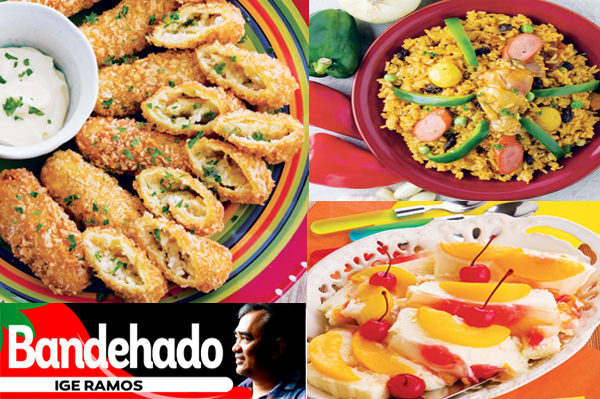
Magarbo ang pagsalubong sa Bagong Taon ng ilang mga Pinoy.
Sa Media Noche, asahan nang nasa kanilang mesa ang ham, salad, manok, lechon, karne na may sarsa at iba-ibang klase ng prutas. Pero para sa karamihan sa atin, malamang ay matutulog na lang matapos ang putukan dahil wala namang ihahanda.
Walang dapat ikahiya kung walang ikakaya.
Ang nakakahiya ay kung mangungutang pa kung kani-kanino upang magpabongga lamang sa mga kapitbahay. At wala rin namang mawawala kung hindi na susundin ang mga tradisyon ng mga ninuno.
Wala sa dami ng pagkain sa mesa ang ikagaganda o ikapapangit ng ating bagong taon–ito ay bunga ng pagsisikap at pagpupunyagi at pananalig sa Maykapal.
Manigong Bagong Taon sa lahat!
Simula sa Lunes ay hindi muna matutunghayan ang inyong paboritong pitak. Pansamantala lamang ito habang ako ay wala sa bansa. Sa ating muling pagkikita, mga mahal kong mambabasa. Maraming-maraming salamat sa inyong pagtangkilik.
A New Year’s Feast
Celebrate the New Year’s Eve by preparing these celebratory dishes that your family will surely enjoy!
For appetizers, the Spicy Fish Croquettes by Mrs Emma Amatong will be an instant hit to the kids as a “nibbler” and it will also make a good “pulutan” for adults.
For the main course, Valenciana Gentriseño by Mrs. Monina S. Ferrer will take your breath away. It may look difficult to do, but once you start cooking this dish, it will be as easy as pie. And the entire family will love it!
For dessert, who wouldn’t say no to Crema de Fruta? A true hipster dessert, with a retro-feel of the 1960s, this will pave the way to a sweet welcome to 2015.
Appetizer
Spicy Fish Croquettes
When her sons turned up their noses at eating fish, Emma Amatong borrowed from their favorite chicken croquettes to make this delicious, kid-friendly dish that the whole family loves. For variety, substitute the malasugue, or marlin, with another firm white fish or crab meat.
Ingredients
150 grams fresh malasugue or yellowfin tuna fillets
Juice of two lemons
Cooking oil
1/2 red onion, chopped finely
2 cloves garlic, minced
250 grams potatoes, mashed
1/2 cup evaporated milk
1/4 teaspoon ground white pepper
1/4 teaspoon chili flakes
Salt to taste
2 stalks green onion, sliced thinly
1 stalk celery, sliced thinly
1 cup all-purpose flour
2 large eggs, beaten
1-1/2 cups panko (Japanese breadcrumbs)
Dipping sauce
3 cloves garlic, minced
1/4 cup mayonnaise
Procedure
Marinate fish fillets in lemon juice for a few minutes, wash, then drain and mince finely.
Heat 1 tablespoon of cooking oil in a nonstick pan and sauté onion, garlic and minced fish.
Cook for a few minutes, then add potatoes, evaporated milk, white pepper, chili flakes and salt, and combine. Turn off heat and mix in green onion and celery. Set aside to cool.
When cool enough to handle, form potato mixture into 1.5-inch sausage shapes. Place flour, eggs and breadcrumbs in 3 separate shallow dishes. Roll a croquette in flour, shaking off excess, then dip in beaten egg and, lastly, coat in panko.
Repeat with remaining croquettes. Heat 2 to 3 cups cooking oil in a frying pan over medium heat. Fry croquettes in small batches for about 3 minutes, turning all sides until crisp and golden brown.
Drain on paper towels.Combine garlic and mayonnaise for a dipping sauce and serve alongside a green salad.
Main Course
Valenciana Gentriseño
Local ingredients and methods transform Paella Valenciana from a classic Spanish recipe into a signature dish celebrated by General Trias township during its annual Valenciana Festival.
Atsuete and coconut milk replace saffron and broth, while the familiar elements of rice, meat and vegetables come together in a kawa (wok) covered with banana leaves, instead of the traditional flat-bottomed paellera.
Ingredients
3 kilograms chicken, cut into pieces 1/2 cup patis
3 kilograms liempo, chopped into pieces
Salt to taste
20 cups water
1/2 cup oil
3 tablespoons atsuete
1/2 cup butter
1/4 cup garlic
5 onions, diced
10 longganisa, sliced
1/4 cup peppercorns
6 cups of coconut milk
1 cup tomato sauce
1 cup catsup
1 kilogram potatoes, cubed
20 cups jasmine rice
1 cup green peas
1/2 cup raisins
1 kilogram hotdogs, cut into pieces
500 grams red bell pepper, cut into strips
Banana leaves
Procedure
Marinate chicken with patis and set aside. In a large stock pot, boil liempo with salt in water until meat is tender. When done, remove pork and reserve the broth.
In a large wok, heat cooking oil and saute atsuete until infused with color, about 3 minutes. Remove seeds and discard. Add butter and sauté garlic, onions, and longganisa, followed by the marinated chicken.
Once chicken is fully cooked, add the boiled liempo and peppercorns, and season with patis to taste. Pour in coconut milk and bring to a boil, then stir in tomato sauce and catsup.
Pour in reserved pork broth, add potatoes and return to a boil. Add jasmine rice and stir continuously until mixture thickens. Spread green peas, raisins, hot dogs and red bell pepper on top, and cover entirely with banana leaves.
Reduce heat, stirring every 10 minutes to ensure even cooking, until rice is tender.
Dessert
Crema de Fruta
In the 1960s, young families embraced modernity at home, particularly in the kitchen. From the latest appliances to convenience foods like canned fruit cocktail and boxed cake mixes, they nurtured new urban neighborhoods amidst traditional communities. Today, a dessert like crema de fruta, created from expedient products and regarded with fond nostalgia, reflects the continued mix of old and new in contemporary residential centers like Parañaque City. Recipe courtesy of Joy Myra Tambunting.
Ingredients
Cake
6 eggs
3/4 cup sugar
1-1/4 cups cake flour, sifted
1/4 teaspoon salt
4 tablespoons melted butter
Custard
5 egg yolks
2-3/4 cups fresh milk
1 cup sugar
1/2 cup cake flour
3/4 cup water
1 teaspoon vanilla
Topping
1 (850 grams) can fruit cocktail or choice of fruit
90 grams unflavored gulaman
Procedure
Preheat oven to 325°F/162°C.
Beat eggs with an electric mixer until fluffy, then add sugar and beat until thick. Whisk flour and salt together, then gently fold a small amount at a time into the egg mixture, along with melted butter.
Carefully pour batter into a rectangular cake pan and bake for 15 to 20 minutes or until a toothpick inserted in the middle comes out clean. Set cake aside to cool.
In a bowl, beat egg yolks, then gradually blend in milk. In a double boiler, whisk together sugar, flour, water and vanilla until combined. While cooking over medium-low heat, gradually stir in milk mixture until blended. Stirring continuously, cook until mixture thickens and begins to boil, about 20 to 25 minutes.
Allow to boil for a minute, then immediately remove from heat. Drain fruit cocktail, reserving the juice and setting aside the fruit. Prepared the gulaman according to package directions and using reserved fruit juice. Set aside to cool.
Pour custard over sponge cake, using a spatula to spread evenly. Arrange fruit cocktail over the custard, then pour gulaman over the fruit. Refrigerate until gelatin has set.
Disclaimer: The comments uploaded on this site do not necessarily represent or reflect the views of management and owner of Bandera. We reserve the right to exclude comments that we deem to be inconsistent with our editorial standards.




